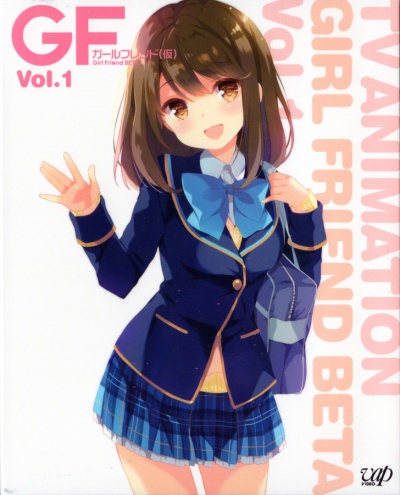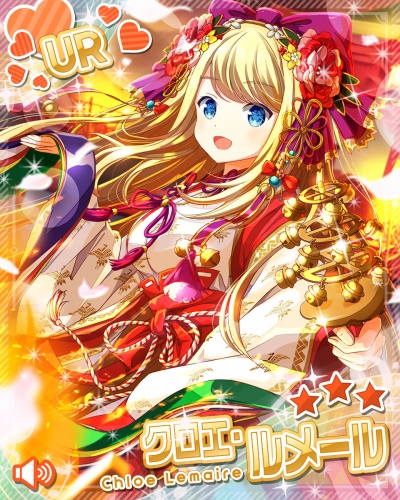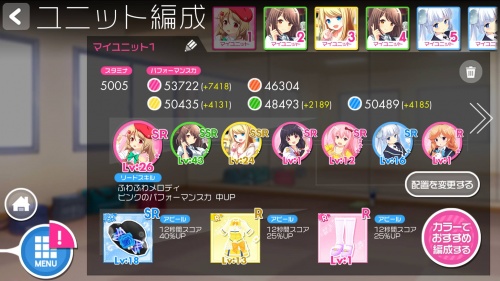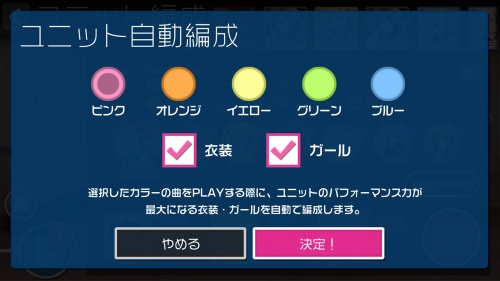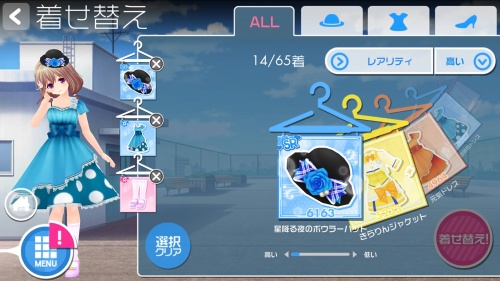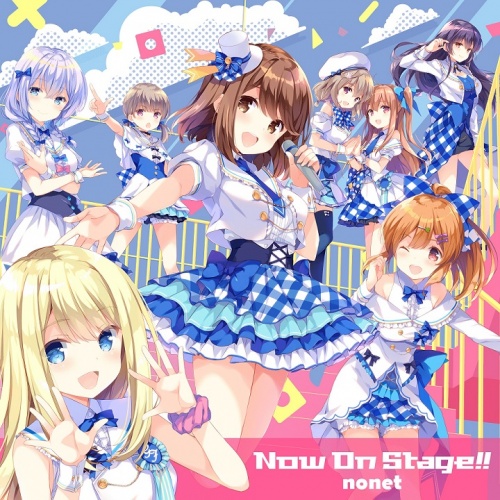Difference between revisions of "Girlfriend Note"
(Added images) (Tag: Visual edit) |
(Added song for 31 July 2016 event) |
||
| (33 intermediate revisions by 3 users not shown) | |||
| Line 1: | Line 1: | ||
| − | + | This page is about the rhythm game spinoff of Girlfriend Kari, Girlfriend Note. | |
| − | + | The contents of this page and the contents of the Girlfriend Note Walkthrough Introduction page are very similar. If you've read one of them, there's no reason to read the other! | |
| + | |||
| + | == Introduction == | ||
| + | Girlfriend (♪) (also known as Girlfriend Onpu and Girlfriend Note) is a 3D rhythm game that was supposed to have been released on December 1st, 2015, but due to server failure and a lot of unexpected problems, the game was left unplayable until roughly December 18th, 2015. It's a mobile rhythm game similar to Love Live: School Idol Festival and the Idolm@ster rhythm games, and is playable on [https://play.google.com/store/apps/details?id=jp.co.cyberagent.gfonpu Android] and [https://itunes.apple.com/jp/app/id979132363?mt=8 iOS]. The game itself is considered a spin-off of the original [[Girlfriend Kari]] series, as it uses the same characters and voice actresses from the card game, although introducing new characters from rival schools to advance the plot of the rhythm game. | ||
| + | |||
| + | You might be wondering - what prompted the creation of a rhythm game to the already successful RNG simulator, Girlfriend Kari? Well there are a few reasons. | ||
| + | |||
| + | The original Girlfriend Kari became incredibly popular in Japan as a social card game - with over 6 million registered users to date! Ameba deployed a simple buisiness strategy - use the appeal of cute cards depicting anime girls released at a surprisingly fast rate to keep players constantly returning for more. And even more - make the drop rates abysmally low so hardcore users will be almost forced to dish out cold, hard cash to obtain the super rare cards that they want. It's a simple strategy, but it worked. | ||
| + | |||
| + | Girlfriend Kari has become popular to the point that the series boasts its own magazine, radio, and giant booths at large conventions. Of course, the game is only that popular in Japan due to the game being fully in Japanese and somewhat challenging for foreign players to get into. | ||
| + | |||
| + | Nonetheless, with its rising popularity, an [[Anime]] adaptation was created. Although somewhat lacking in quality, the anime was successful as an advertisement to the series. Along with the anime, a bunch of character song albums were released, each containing five to six songs that a specific character's voice actress sings. | ||
| + | [[File:Characteralbumvol1.jpg|centre|thumb|495x495px|alt=Cover for the first character album|Cover for the first character album]] | ||
| + | |||
| + | Now, what's the best way to make money off of a bunch of character songs that have already been released? You create a rhythm game out of them. And thus, Girlfriend Note was born. | ||
| + | |||
| + | Below, we'll give a brief overview of the story behind the game, and a quick look of what the game has in store for you! | ||
| + | |||
| + | == Prologue == | ||
| + | See below for the official introduction video of Girlfriend Note. If you haven't seen it already, I'd recommend taking a look - it's super cute, and bound to brighten up your day. | ||
| + | |||
| + | <center><youtube>OBQokbKBPtM</youtube></center> | ||
| + | |||
| + | In summary, a new headmaster at Seiou Gakuen (聖櫻学園) has enrolled all special outstanding students into a dance battle royale against rival schools! The winning team will get...prizes...of some kind... | ||
| + | |||
| + | In order to determine who the leader of the new dance units will be, a lottery gacha is run! And guess what? YOU'VE been selected as the leader! Congratulations! | ||
| + | |||
| + | Now, it's time for you to enter the fray, form your units, and destroy the competition with cute waifu power! | ||
| − | |||
== Gameplay == | == Gameplay == | ||
| − | + | As stated above, the core gameplay is very similar to Love Live: School Idol Festival and The iDOLM@STER Cinderella Girls: Starlight Stage. Players will assemble units of girls categorized according to various attributes (here, just according to five colors: Pink, Orange, Yellow, Green, and Blue) and use these units to score well on songs. Below is a brief video showcasing the gameplay of one of the songs! | |
| − | |||
| − | |||
| − | + | <center><youtube>qx3elH4F5-g</youtube></center> | |
| − | + | If you're familiar with Love Live: School Idol Festival, you'll notice that this game plays almost exactly the same to it. The tap zones are eight hearts arranged in a semicircular fashion, very close to SIF's 9-circle semicircular layout. You need to tap the hearts when the heart from the inner circle overlaps with the heart in the tap zone. There are also double notes, which are shown by hearts that have shaded-in hearts within them, and hold notes too! The bottom center, however, gives an entirely different element, unseen in either SIF or Starlight Stage: a disco ball that the player must keep spinning for a score bonus. In order to keep the disco ball spinning, you have to occasionally swipe it every ~8 seconds, otherwise it will stop spinning and you'll lose your score bonus (which is about 20%)! | |
| − | + | The video above shows the "hard" difficult for the song, 100% Fresh, which is [[Ichigo Kohinata]]'s character song. There are four available difficulties for all the songs - Easy, Normal, Hard, and Very Hard (Expert). In order to play a song, you have to use stamina! Stamina regenerates at a decent rate (1 point every 6 minutes, so 10 points every hour), but it makes it so that you can't just keep playing forever. This is a common gimmick found in most rhythm games. | |
| − | + | Now, for every song you play, you have to choose a unit! You can't just participate in dance battles without a set of girls! Your units are composed of girls that you obtain from cards. All cards have their own rarity, and the general rule of thumb with cards is that the rarer the card, the better stats it will have. Card rarity goes from N -> R -> SR -> SSR -> UR. You can also level up your own girls by sending other girls to train with them (essentially using other girls to feed another card for EXP gain). There's also evolution - where you can combine two copies of the same card to increase the max potential of the card! Combining three copies fo the same card will then result in substantially different artwork, and the card gaining a rarity level! | |
| + | [[File:Chloelemairesample.jpg|centre|500x500px|alt=A Chloe UR card!|thumb|A Chloe UR card!]] | ||
| − | == | + | Unit composition is generally based around a color attribute. You'll want to have at least 5 units built - one focused around each color attribute, so you can choose the right one to maximize score during the performance. You want to set your card with the best leader skill for the attribute that you want to focus on into the first slow (this is generally your rarest card). Then, place other team members around focusing around the same color! A quick note, however - using rarer cards of a different color than the one you're focusing on might be better than using a card of a low rarity but of the color you're focusing on. |
| − | # Tanoshiki Tokimeki by Neuron★Creamsoft ([[ | + | [[File:Unitcontrol.jpg|alt=Screenshot of the Unit page|centre|thumb|500x500px|Screenshot of the Unit page]] |
| + | |||
| + | Don't worry there's an automatic team builder that creates the best team using the cards from your inventory. You can tell it what color attribute to focus on too! The automatic unit selector will work most of the time, unless you're considering individual skills on the cards as well - but that's far too advanced for this guide. We'll explain more about unit composition later, but this hopefully serves as an introduction to the mechanics. | ||
| + | [[File:Unitautomaticselect.jpg|alt=Auto-creation of a unit based on color priority!|centre|thumb|500x500px|You can use the auto team builder to focus on a specific color! It's pretty useful.]] | ||
| + | |||
| + | Finally, you have to choose which girl you actually see dancing on the screen when you perform! This girl is independent from your cards, and is called the Center Girl. You start off with only one center girl - which you can choose from a pool of currently available models (Ameba is still releasing more 3D models, so expect more in the future). As you level up, you'll gain more center girl slots, allowing you to have more dancers/models to choose from when performing songs. For each center girl, you can talk to them, poke them, increase your bond with them, and...dress them up? | ||
| + | |||
| + | Yes, you can play dress-up with your cute waifus! You can equip a hat slot item (like glasses, a headband, a barrette, etc), a body slot item (like a dress), and a leg slot item (like boots, sandals, etc). All clothing is also color-attributed and gives a stat bonus, and when playing, you can select up to two of your three clothing items to be used for their abilities, which you can activate while playing the song by tapping on an icon on either side of the screen. The center girl you choose to perform will also be wearing the clothing you selected! | ||
| + | [[File:Costumechanging.jpg|alt=You can change Haruka's clothes!|centre|thumb|500x500px|You can change Haruka's clothes! Isn't she cute?]] | ||
| + | |||
| + | In short, get cute cards of cute girls and build a team out of them, then use that team along with a 3D model to perform well on stage! | ||
| + | |||
| + | == Songs == | ||
| + | {{Main|Rhythm:Songs|Rhythm:Song Gallery}} | ||
| + | What's a rhythm game without music? Girlfriend Kari has plenty of that! With the release of an anime (and tons of character album CDs as a result), there's plenty of songs to make a rhythm game out of! The game has also brought a lot of new songs to the series too - and Ameba has also confirmed that they are still working on more songs for the game as well. Event-limited songs (like seasonal songs) will appear occasionally too! As of March 2016, there are over 50 playable songs! You can check out the full gallery of songs at our [[Rhythm:Song Gallery | Song Gallery]] page! | ||
| + | [[File:Mj 35 nowonstage.jpg|alt=Album cover for the newly released song for the rhythm game, Now on Stage!|centre|thumb|500x500px|Album cover for the newly released song for the rhythm game, Now on Stage!]] | ||
| + | Below is a list of the currently playable songs in the game. | ||
| + | # Tanoshiki Tokimeki by Neuron★Creamsoft ([[Momoko Asahina]], [[Kurumi Eto]], [[Haruka Kazemachi]], [[Nagiko Kurokawa]], [[Sumire Yomogida]]) | ||
# Zenryoku Heroine! by [[Tsugumi Harumiya]] | # Zenryoku Heroine! by [[Tsugumi Harumiya]] | ||
| − | # NPM na | + | # NPM na Kanojo desu (~Nippon Moe na Kanojo desu~) by [[Chloe Lemaire]] |
# Mirai Episode by [[Mahiro Natsume]] | # Mirai Episode by [[Mahiro Natsume]] | ||
# Sewing My MODE by [[Koruri Tokitani]] | # Sewing My MODE by [[Koruri Tokitani]] | ||
| Line 30: | Line 72: | ||
# Hibike! Doremi♪ by Momoko Asahina | # Hibike! Doremi♪ by Momoko Asahina | ||
# Scandal wa Ikaga? by [[Saya Kagurazaka]] | # Scandal wa Ikaga? by [[Saya Kagurazaka]] | ||
| − | # Hareru Ka Naa by [[Kokomi Shina]] | + | # Hareru Ka Naa by [[Kokomi Shina|Kokomi Shiina]] |
# Wake Up My Love -Otome no Junjou- by [[Akane Sakurai]] | # Wake Up My Love -Otome no Junjou- by [[Akane Sakurai]] | ||
# Chiisana Cafe no Ano Sekide by [[Nonoka Sasahara]] | # Chiisana Cafe no Ano Sekide by [[Nonoka Sasahara]] | ||
| Line 38: | Line 80: | ||
# Meguru Meguru Seitokai Days by [[Mutsumi Shigino]] | # Meguru Meguru Seitokai Days by [[Mutsumi Shigino]] | ||
# Seasons of Silence by [[Risa Shinomiya]] | # Seasons of Silence by [[Risa Shinomiya]] | ||
| − | # Tegami o Kaku no by [[Yukie Yatuka]] | + | # Tegami o Kaku no by [[Yukie Yatuka|Yukie Yatsuka]] |
# Haruka Kanata de Yume Mimasho by [[Kanata Amatsu]] | # Haruka Kanata de Yume Mimasho by [[Kanata Amatsu]] | ||
# Kokoro Jiyuu Sengen by [[Michiru Tomura]] | # Kokoro Jiyuu Sengen by [[Michiru Tomura]] | ||
| Line 45: | Line 87: | ||
# Narite Hana Ichimonme by [[Eiko Hibara]] | # Narite Hana Ichimonme by [[Eiko Hibara]] | ||
# Winter Chime by nonet (Fumio Murakami, Chloe Lemaire, Kokomi Shiina, Mutsumi Shigino, Momoko Asahina, Haruka Kazemachi, Akane Sakurai, Saya Kagurazaka) | # Winter Chime by nonet (Fumio Murakami, Chloe Lemaire, Kokomi Shiina, Mutsumi Shigino, Momoko Asahina, Haruka Kazemachi, Akane Sakurai, Saya Kagurazaka) | ||
| + | # Motto-Motto JUMP! by [[Tsugumi Harumiya]] | ||
| + | # 100% Fresh by [[Ichigo Kohinata]] | ||
| + | # Mousou♥Motion by [[Erena Mochizuki]] | ||
| + | # Now On Stage!! by nonet | ||
| + | # Ayaka Hayashi by [[Isuzu Shiranui]] | ||
| + | # One day... by [[Saeko Arisugawa]] | ||
| + | # Muchuu Traveler by Kanata Amatsu | ||
| + | # Fight Ippon! by [[Kazuha Kumada]] | ||
| + | # Kiyoku Tadashiku? School Days by Seio Council (Risa Shinomiya, Kanata Amatsu, Mutsumi Shigino) | ||
| + | # One step! by Auto Focus (Erena Mochizuki and Fumio Murakami) | ||
| + | # I Say, I Love by Symphonia ([[Moeka Nitta]], Saeko Arisugawa, [[Maya Yukikaze]], [[Shiori Shiratori]]) | ||
| + | # Believe Myself by Kokomi Shiina | ||
| + | # Soyokaze no Pirouette by [[Yulia Valkova]] | ||
| + | # Koibito Muffler by [[Nae Yuki|Nae Yūki]] | ||
| + | # Otome Musou Chloe-tan by Chloe Lemaire | ||
| + | # Shinka-kei girl by Neuron★Creamsoft | ||
| + | # Sketch by [[Ayame Chiyoura]] | ||
| + | # Ore no Kokoro ga Moete Iru no Sa…! ~Miyauchi no Theme~ by [[Nozomi Miyauchi]] | ||
| + | # Hey You! Aibou by [[Rino Suzukawa]] | ||
| + | # Pentatonic Love by [[Kurumi Eto]] | ||
| + | # Amari no Ikenie Splatter by [[Akari Amari]] | ||
| + | # Mamimumeso by [[Mei Morizono]] | ||
| + | # Anata dake no Maison de Couture by Maison de Couture (Koruri Tokitani, Nae Yūki, Nao Miyoshi) | ||
| + | # Nippon wa Kyomibukai no desu by Etoile (Chloe Lemaire, Yulia Valkova) | ||
| + | # Gunjou to Contrail by C-gumi Cantabile (Akane Sakurai, Tsugumi Harumiya, Kazuha Kumada, Yukie Yatsuka) | ||
| + | # Futari de Tabi ni Deru Riyuu wa? by Iris (Isuzu Shiranui, Haruko Yumesaki) | ||
| + | # Yume no Hanashi by Fumio Murakami | ||
| + | # Precious note by Haruka Kazemachi | ||
| + | # Egao no Susume by [[Kyoko Tachibana]] | ||
| + | # HAJIkete Synapse☆Cinnamon Roll by Neuron★Creamsoft | ||
| + | # Yumeiro Diary by Yumeiro Diary (Tsugumi Harumiya, Mahiro Natsume) | ||
| + | # Mashiro na Mirai by [[Toko Mashiro]] | ||
| + | # Nejikuru Particle by Raimu Nejikawa | ||
| + | # Netchuu Muchuu☆Diary by Meru (Matsuri Kagami, Emi Sagara, Rino Suzukawa) | ||
| + | # H.He.Li.Be.B.C.N.O.F.Ne. by [[Kise Yukawa]] | ||
| + | # Shining Ray by Flora Flore ([[Yuki Hanafusa]], [[Yuka Koizumi]], [[Misuzu Toyama]]) | ||
| + | |||
| + | Like what you see? Check out the rest of the wiki for more information about the game, and how to get started! | ||
Latest revision as of 07:43, 30 July 2016
This page is about the rhythm game spinoff of Girlfriend Kari, Girlfriend Note.
The contents of this page and the contents of the Girlfriend Note Walkthrough Introduction page are very similar. If you've read one of them, there's no reason to read the other!
Contents
Introduction
Girlfriend (♪) (also known as Girlfriend Onpu and Girlfriend Note) is a 3D rhythm game that was supposed to have been released on December 1st, 2015, but due to server failure and a lot of unexpected problems, the game was left unplayable until roughly December 18th, 2015. It's a mobile rhythm game similar to Love Live: School Idol Festival and the Idolm@ster rhythm games, and is playable on Android and iOS. The game itself is considered a spin-off of the original Girlfriend Kari series, as it uses the same characters and voice actresses from the card game, although introducing new characters from rival schools to advance the plot of the rhythm game.
You might be wondering - what prompted the creation of a rhythm game to the already successful RNG simulator, Girlfriend Kari? Well there are a few reasons.
The original Girlfriend Kari became incredibly popular in Japan as a social card game - with over 6 million registered users to date! Ameba deployed a simple buisiness strategy - use the appeal of cute cards depicting anime girls released at a surprisingly fast rate to keep players constantly returning for more. And even more - make the drop rates abysmally low so hardcore users will be almost forced to dish out cold, hard cash to obtain the super rare cards that they want. It's a simple strategy, but it worked.
Girlfriend Kari has become popular to the point that the series boasts its own magazine, radio, and giant booths at large conventions. Of course, the game is only that popular in Japan due to the game being fully in Japanese and somewhat challenging for foreign players to get into.
Nonetheless, with its rising popularity, an Anime adaptation was created. Although somewhat lacking in quality, the anime was successful as an advertisement to the series. Along with the anime, a bunch of character song albums were released, each containing five to six songs that a specific character's voice actress sings.
Now, what's the best way to make money off of a bunch of character songs that have already been released? You create a rhythm game out of them. And thus, Girlfriend Note was born.
Below, we'll give a brief overview of the story behind the game, and a quick look of what the game has in store for you!
Prologue
See below for the official introduction video of Girlfriend Note. If you haven't seen it already, I'd recommend taking a look - it's super cute, and bound to brighten up your day.
In summary, a new headmaster at Seiou Gakuen (聖櫻学園) has enrolled all special outstanding students into a dance battle royale against rival schools! The winning team will get...prizes...of some kind...
In order to determine who the leader of the new dance units will be, a lottery gacha is run! And guess what? YOU'VE been selected as the leader! Congratulations!
Now, it's time for you to enter the fray, form your units, and destroy the competition with cute waifu power!
Gameplay
As stated above, the core gameplay is very similar to Love Live: School Idol Festival and The iDOLM@STER Cinderella Girls: Starlight Stage. Players will assemble units of girls categorized according to various attributes (here, just according to five colors: Pink, Orange, Yellow, Green, and Blue) and use these units to score well on songs. Below is a brief video showcasing the gameplay of one of the songs!
If you're familiar with Love Live: School Idol Festival, you'll notice that this game plays almost exactly the same to it. The tap zones are eight hearts arranged in a semicircular fashion, very close to SIF's 9-circle semicircular layout. You need to tap the hearts when the heart from the inner circle overlaps with the heart in the tap zone. There are also double notes, which are shown by hearts that have shaded-in hearts within them, and hold notes too! The bottom center, however, gives an entirely different element, unseen in either SIF or Starlight Stage: a disco ball that the player must keep spinning for a score bonus. In order to keep the disco ball spinning, you have to occasionally swipe it every ~8 seconds, otherwise it will stop spinning and you'll lose your score bonus (which is about 20%)!
The video above shows the "hard" difficult for the song, 100% Fresh, which is Ichigo Kohinata's character song. There are four available difficulties for all the songs - Easy, Normal, Hard, and Very Hard (Expert). In order to play a song, you have to use stamina! Stamina regenerates at a decent rate (1 point every 6 minutes, so 10 points every hour), but it makes it so that you can't just keep playing forever. This is a common gimmick found in most rhythm games.
Now, for every song you play, you have to choose a unit! You can't just participate in dance battles without a set of girls! Your units are composed of girls that you obtain from cards. All cards have their own rarity, and the general rule of thumb with cards is that the rarer the card, the better stats it will have. Card rarity goes from N -> R -> SR -> SSR -> UR. You can also level up your own girls by sending other girls to train with them (essentially using other girls to feed another card for EXP gain). There's also evolution - where you can combine two copies of the same card to increase the max potential of the card! Combining three copies fo the same card will then result in substantially different artwork, and the card gaining a rarity level!
Unit composition is generally based around a color attribute. You'll want to have at least 5 units built - one focused around each color attribute, so you can choose the right one to maximize score during the performance. You want to set your card with the best leader skill for the attribute that you want to focus on into the first slow (this is generally your rarest card). Then, place other team members around focusing around the same color! A quick note, however - using rarer cards of a different color than the one you're focusing on might be better than using a card of a low rarity but of the color you're focusing on.
Don't worry there's an automatic team builder that creates the best team using the cards from your inventory. You can tell it what color attribute to focus on too! The automatic unit selector will work most of the time, unless you're considering individual skills on the cards as well - but that's far too advanced for this guide. We'll explain more about unit composition later, but this hopefully serves as an introduction to the mechanics.
Finally, you have to choose which girl you actually see dancing on the screen when you perform! This girl is independent from your cards, and is called the Center Girl. You start off with only one center girl - which you can choose from a pool of currently available models (Ameba is still releasing more 3D models, so expect more in the future). As you level up, you'll gain more center girl slots, allowing you to have more dancers/models to choose from when performing songs. For each center girl, you can talk to them, poke them, increase your bond with them, and...dress them up?
Yes, you can play dress-up with your cute waifus! You can equip a hat slot item (like glasses, a headband, a barrette, etc), a body slot item (like a dress), and a leg slot item (like boots, sandals, etc). All clothing is also color-attributed and gives a stat bonus, and when playing, you can select up to two of your three clothing items to be used for their abilities, which you can activate while playing the song by tapping on an icon on either side of the screen. The center girl you choose to perform will also be wearing the clothing you selected!
In short, get cute cards of cute girls and build a team out of them, then use that team along with a 3D model to perform well on stage!
Songs
- Main pages: Rhythm:Songs and Rhythm:Song Gallery
What's a rhythm game without music? Girlfriend Kari has plenty of that! With the release of an anime (and tons of character album CDs as a result), there's plenty of songs to make a rhythm game out of! The game has also brought a lot of new songs to the series too - and Ameba has also confirmed that they are still working on more songs for the game as well. Event-limited songs (like seasonal songs) will appear occasionally too! As of March 2016, there are over 50 playable songs! You can check out the full gallery of songs at our Song Gallery page!
Below is a list of the currently playable songs in the game.
- Tanoshiki Tokimeki by Neuron★Creamsoft (Momoko Asahina, Kurumi Eto, Haruka Kazemachi, Nagiko Kurokawa, Sumire Yomogida)
- Zenryoku Heroine! by Tsugumi Harumiya
- NPM na Kanojo desu (~Nippon Moe na Kanojo desu~) by Chloe Lemaire
- Mirai Episode by Mahiro Natsume
- Sewing My MODE by Koruri Tokitani
- Smile Day by Emi Sagara
- Shiori by Fumio Murakami
- Kankitsukei no Et Cetera by Yuzuko Hazuki
- Yume no Hanashi by Haruko Yumesaki
- Border Line by Matsuri Kagami
- Hibike! Doremi♪ by Momoko Asahina
- Scandal wa Ikaga? by Saya Kagurazaka
- Hareru Ka Naa by Kokomi Shiina
- Wake Up My Love -Otome no Junjou- by Akane Sakurai
- Chiisana Cafe no Ano Sekide by Nonoka Sasahara
- Robotics∞<Infinity> by Raimu Nejikawa
- Sonotoki, FantasticGirl! by Nao Miyoshi
- Nyokinyoki Denpashi by Kinoko Himejima
- Meguru Meguru Seitokai Days by Mutsumi Shigino
- Seasons of Silence by Risa Shinomiya
- Tegami o Kaku no by Yukie Yatsuka
- Haruka Kanata de Yume Mimasho by Kanata Amatsu
- Kokoro Jiyuu Sengen by Michiru Tomura
- Futari de Tsuzuru Monogatari by Fumio Murakami
- White Xmas by Miss Monochrome
- Narite Hana Ichimonme by Eiko Hibara
- Winter Chime by nonet (Fumio Murakami, Chloe Lemaire, Kokomi Shiina, Mutsumi Shigino, Momoko Asahina, Haruka Kazemachi, Akane Sakurai, Saya Kagurazaka)
- Motto-Motto JUMP! by Tsugumi Harumiya
- 100% Fresh by Ichigo Kohinata
- Mousou♥Motion by Erena Mochizuki
- Now On Stage!! by nonet
- Ayaka Hayashi by Isuzu Shiranui
- One day... by Saeko Arisugawa
- Muchuu Traveler by Kanata Amatsu
- Fight Ippon! by Kazuha Kumada
- Kiyoku Tadashiku? School Days by Seio Council (Risa Shinomiya, Kanata Amatsu, Mutsumi Shigino)
- One step! by Auto Focus (Erena Mochizuki and Fumio Murakami)
- I Say, I Love by Symphonia (Moeka Nitta, Saeko Arisugawa, Maya Yukikaze, Shiori Shiratori)
- Believe Myself by Kokomi Shiina
- Soyokaze no Pirouette by Yulia Valkova
- Koibito Muffler by Nae Yūki
- Otome Musou Chloe-tan by Chloe Lemaire
- Shinka-kei girl by Neuron★Creamsoft
- Sketch by Ayame Chiyoura
- Ore no Kokoro ga Moete Iru no Sa…! ~Miyauchi no Theme~ by Nozomi Miyauchi
- Hey You! Aibou by Rino Suzukawa
- Pentatonic Love by Kurumi Eto
- Amari no Ikenie Splatter by Akari Amari
- Mamimumeso by Mei Morizono
- Anata dake no Maison de Couture by Maison de Couture (Koruri Tokitani, Nae Yūki, Nao Miyoshi)
- Nippon wa Kyomibukai no desu by Etoile (Chloe Lemaire, Yulia Valkova)
- Gunjou to Contrail by C-gumi Cantabile (Akane Sakurai, Tsugumi Harumiya, Kazuha Kumada, Yukie Yatsuka)
- Futari de Tabi ni Deru Riyuu wa? by Iris (Isuzu Shiranui, Haruko Yumesaki)
- Yume no Hanashi by Fumio Murakami
- Precious note by Haruka Kazemachi
- Egao no Susume by Kyoko Tachibana
- HAJIkete Synapse☆Cinnamon Roll by Neuron★Creamsoft
- Yumeiro Diary by Yumeiro Diary (Tsugumi Harumiya, Mahiro Natsume)
- Mashiro na Mirai by Toko Mashiro
- Nejikuru Particle by Raimu Nejikawa
- Netchuu Muchuu☆Diary by Meru (Matsuri Kagami, Emi Sagara, Rino Suzukawa)
- H.He.Li.Be.B.C.N.O.F.Ne. by Kise Yukawa
- Shining Ray by Flora Flore (Yuki Hanafusa, Yuka Koizumi, Misuzu Toyama)
Like what you see? Check out the rest of the wiki for more information about the game, and how to get started!
